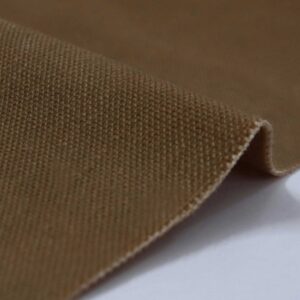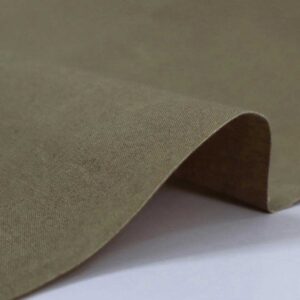Waxed Canvas A Durable and Water-Resistant Fabric for Outdoor Gear
Waxed Canvas Fabric
Waxed canvas fabric is a durable water-resistant fabric that has been around since ancient times. Historically, it was not just sailors who used the garment to protect against foul weather at sea. Widely used manufacturing bags, jackets and other outdoor gear.
Waxed canvas is a way of applying wax to the fabric enabling it to be repellent and waterproof. You can apply warm wax to the fabric using a brush or a roller. After the impregnation process the wax heats up to absorb into fabric fibers. The result is a rugged and waterproof fabric. Cotton canvas fabric comes in various colors and weights much like fabric.
History and Development of Waxed Canvas Fabric
Origins and Early Uses
Waxed canvas fabric has existed for centuries sailors invented it in the mid-19th century. Then learned to waterproof them by spreading linseed oil on them which increased their durability and decreased the sail weight. Workers invented the waxed canvas by applying heavy cotton canvas and waxing it. The end product was a fabric resistant to harsh weather and they began manufacturing it for the marine industry.
Evolution and Modern Applications
It has been an industry secret wax canvas fabric is nothing new. It also makes bags, jackets, headwear and other outdoor equipment. Canvas waxed fabric is tough and can take a beating whether rain or snow. Give a thought to camping or fishing.
Waxed canvas is one of the more waterproof fabrics for wallets which can be great if you live in a rainy or snowy climate. Canvas waxed fabric is growing in popularity among eco-conscious consumers to a significant extent because the product is biodegradable and naturally materializable.
Properties of Waxed Canvas Fabric
Material Characteristics
Waxed canvas is a durable water-resistant fabric used in the sailing industry for centuries. A beeswax and paraffin mix seeps into the fabric to achieve the specialty effect. With its water-repellent nature waxed canvas lasts because of its highly hardy properties. It was previously used on goods like jackets and tents.
High friction more personalized sounds like it is luxurious. It is also a very breathable fabric so you do not need to worry about overheating in various weather conditions.
Waterproofing and Re-Waxing Techniques
Waxed canvas will lose its waxy sheen over time and decreasing water resistance. Re-waxing is a necessary wool canvas treatment to keep your jacket water-resistant as it wears off if you have been washing well.
Several methods for re-waxing waxed canvas include applying a new layer of wax using a block of luggage or clothing-style fabric treatment gloves to rub it in the heat set. Wax was previously used to treat goods like jackets and tents. Melt the wax and apply it evenly over the fabric using a cotton cloth or your fingers. Dry it by heating it so the wax will absorb into the fabric.
Uses of Waxed Canvas
- Clothing: Waxed Canvas is mostly used for outerwear like jackets and coats. Its durability and water-resistant properties have also seen canvas used for casual and outdoor wear.
- Bags and Backpacks: Waxed canvas is an excellent bag material for everything from stylish handbags to durable backpacks. Although most famous for making sleek backpacks and messenger bags the jacket is also water-resistant so unlike its competitors rain or other forms of moisture won’t get through.
- Outdoor Gear: Waxed canvas is commonly used by outdoor enthusiasts for tents, tarps, and hunting gear. It is not only super durable but also waterproof ideal for extreme weather conditions.
- Furniture Covers: Cover your outdoor furniture with waxed canvas to avoid dirt and wetness.
- Home Décor: Not only is waxed canvas great for home decor like cushions, throws, and wall hangings to give a rustic effect and durable touch to interiors.
Modern Manufacturing Processes
The manufacture of modern waxed canvas first involves creating high-quality cotton canvas. First, we pre-wash the fabric to clean impurities and prepare it for waxing. The manufacture of waxed canvas involves many steps. We coat the woven cotton canvas with wax often paraffin wax, natural oil, and beeswax.
We heat the fabric to melt the wax and allow it to penetrate all fibers offering some weather resistance. This is labor-intensive work performed by Hassan Brothers Textile by hand or with specialized machines. After applying the wax allow it to cool and harden before cutting into products.
Waxed Canvas Techniques and Methods
It is crucially essential to the wax manufacturing step. Conditioning is the application of a wax preparation to impregnate the canvas and make it watertight. For waxed canvas, you can use multiple techniques hand waxed or spray waxed machine.
Machine spray is waxed directly onto canvas to absorb it more effectively into the fabric. The machine is used to apply the wax to the canvas.
Quality Control and Testing
Quality control is a crucial part of waxed canvas production. Improvements directly affect the appeal and functionality. Hassan Brothers Textile rigorously test the final clothing products to ensure the design of high-quality and durable items.
Testing including water and winter weather wind. Ensures the waxed canvas meets resistance tests for water repellency and foul weather resilience. We also test each color to determine if it is permanent or sure that the waxed canvas loses its original appearance and consequently gains character.
Conclusion
Waxed canvas manufacturers today create high-quality cotton canvas fabric. Apply a coating in numerous ways and test the finish with several quality control checks to ensure top-tier results. Canvas fabric with its waxed finish has endured as a classic material for several centuries. This material is the most durable and water-resistant with a design other than metal and has been used in various applications from fashion to outdoor gear. Learn how to properly use waxed canvas fabric to take advantage of all it offers year-round.



